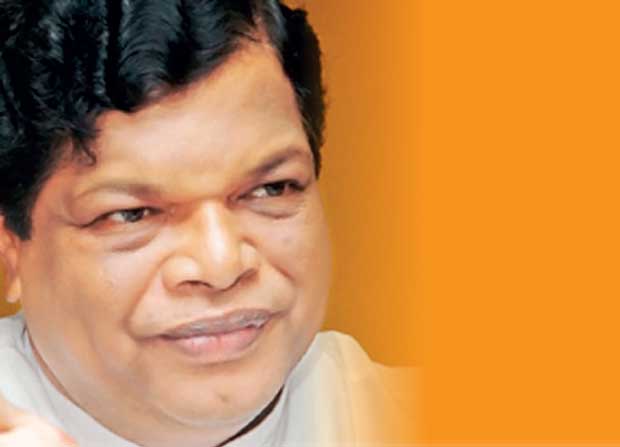Current Govt. worsened debt crisis -Bandula
Posted on August 30th, 2017
By Kelum Bandara Courtesy The Daily Mirror
- Under China’s Belt and Road Initiative, Hambantota Port is the proverbial goose laying golden eggs
- MP Ravi Karunanayake held responsible for debt crisis
- Mega projects bring dividends only in the long run
- The current regime has doubled the amount of annual borrowings during the short period it has been in power
- We had maintained public debt at manageable level. It was worsened after the new government assumed office
- We can say Rs.330 billion would suffice to settle all these loans together with interests accrued

Q The government always says that it inherited a huge debt burden from the previous government, you represented. The govt. maintains that the country can’t move forward as a result. What is your response?
This is falsehood created with a petty political vendetta in mind. It has no rationale. It is a political slogan. Actually, Prime Minister Ranil Wickremesinghe had to face the biggest debt crisis in 2001 during the post-independence period. Public debt accounted for 103 .3 percent of the GDP in 2001, 105.6 percent in 2002, 102.3 percent in 2003 and 102.3 in 2004. It’s the biggest debt crisis. The Prime Minister made a statement to the nation and stated the same in Parliament. He was under immense pressure to address the crisis. As a result, he introduced the Fiscal Responsibility Act No 3 of 2003. It provided for the fact that the government could make borrowings on ad hoc basis.

Though the Act was brought by him, its implementation took place during the time of former President Mahinda Rajapaksa. The former President had to grapple with seven issues. Among them the most essential ones were to rebuild the country devastated by the Tsunami, resurrect the country from terrorism and find a way out of the global oil and food crises. Besides, he had to cope with the global credit crunch and the debt crisis locally. The economy was stagnant.
By 2014, he managed to reduce the debt burden to 71.6 percent of GDP. However, former Finance Minister Ravi Karunanayake messed up the situation under the current regime.
During the period between 2005 and 2014, public debt rose only by Rs.517 billion annually on average. Karunanayake made borrowings after the new government took office. In 2014, outstanding public debt amount was Rs.7391 billion. In 2016, it was Rs.9402 billion. During the two year period, the annual increase of public debt amount was Rs.1095. It means the current regime has doubled the amount of annual borrowings during the short period it has been in power.
The Auditor General, in his report to Parliament, observed that the Public debt accounted for 83.3 percent of the GDP.
So, it’s a move by the government to cover up its incompetence. We had maintained public debt at manageable level. It was worsened after the new government assumed office.
By 2014, he managed to reduce the debt burden to 71.6 percent of GDP. However, former Finance Minister Ravi Karunanayake messed up the situation under the current regime
Q The government says it’s facing a crisis in settling external borrowings made by your government. What is your view?
It’s yet another irrational argument. As for the mega development projects of Sri Lanka, the government got Rs.175 billion for the Hambantota Port, Rs.27 billion for the Mattala Airport, Rs. 19 billion for the military complex, Rs.10 billion for the Lotus Tower, Rs. 3 billion for the Hambantota Conference Hall, Rs.14 billion for Mihin Lanka, 0.5 percent for the Technical Park in Suriyaweva and Rs. 41 billion for the Matara-Beliatte Railway Line. For all of them, the amount is only Rs.289 billion.
We can say Rs.330 billion would suffice to settle all these loans together with interests accrued. However, this government had a huge advantage due to the drop of fuel prices in the world market. It could save as much as Rs.620 billion in fuel imports under relatively low prices.
At that time, it cost US $ 4597 million to import fuel during the crisis period. In 2015, it dropped to US $ 2700 million. In 2016, it further dropped to US $ 2481million.
At present, the fuel bill accounts for 11 percent of the total import cost. The government could save a lot of foreign exchange. No other government had such an advantage in the global context. If we had that advantage, we could have performed miracles. Yet, the savings in terms of US dollars were lost without any valid purpose. Karunanayake said he would bring the dollar rate to Rs.130 within a week. He asked the Central Bank to make interventions by releasing dollar savings to the market. Finally, it didn’t even serve the intended purpose. The dollar rate rose to Rs.151 finally. Besides, investors also pulled back their dollar investments. Altogether we lost US $ 6 billion. Had we been able to keep it with us, we wouldn’t have faced any crisis in debt servicing.
In 2015, it cost US $ 4.6 for debt serving. In 2016, it was only US $ 4.4 billion. The government could have found foreign exchange for it from savings in fuel imports.
Today, the Bank of Ceylon and the People’s Bank successfully compete with private banks. I am not opposed to the involvement of the private sector in the management of ventures and other areas. I don’t admit that the state sector can’t manage commercial ventures
Q The government says the projects such as the Hambantota Port are white elephants. It justified the lease agreement in that manner. What is your view?
One can look at the 1952 report on the Colombo Port. After such a long time since its construction, the operational profit was only Rs.2 million. These mega projects are risk capital investments. They yield results in the long run only. Far sighted economists don’t look at short term gains from such projects. The Mahaweli project was implemented with external borrowings. It was a project worth Rs.500 billion. If it were left to be executed today, even Rs.5000 billion wouldn’t have sufficed. One shouldn’t look at mega projects through the prism of petty politics.
Under the Belt and Road Initiative of China, Kra Canal is being constructed for naval movements. Once that is done, the Hambantota Port can be best described by the proverbial phrase ‘the goose who lays the golden eggs’. If not for the construction of the Norochcholai Coal Project, using loans, we would have lost 900 megawatts of electricity to the national grid.
In 2009, we bought military equipment- artillery guns, MiG etc- and fought the war. If not for that, Prabhakaran would have been alive even today. Then, what would be the end result?
In the world today, borrowings are made to execute major projects. That is to avoid pressure from future price hikes. If you look at a high-rise building, its owner would have spent money only to lay its foundation. He has built the rest through a loan. We face the two gap theory of development in economics. Our savings increase slowly. When we improve investments, it leaves a gap between savings and investments. That gap has to be filled with external borrowings and grants. I always encourage speedy development of mega projects. Otherwise, those will become the dreams of future generations.
South Korea was lagging behind us. In the past, the then Korean leader took steps to build expressways. People protested. During some clashes, people were even killed. Yet, he built the road network. It’s a country that set an example to the world. It developed by investing on infrastructure and human capital.
Karunanayake said he would bring the dollar rate to Rs.130 within a week. He asked the Central Bank to make interventions by releasing dollar savings to the market. Finally, it didn’t even serve the intended purpose
Q Also, the government says it will obtain the tranche of US $ 400 million for the Hambantota Port agreement in December. It says this amount, along with other investments, will help stabilize the economy. Do you agree?
The government should announce to the people how it would recover US $ 6 billion which was lost without any benefit. The government has to spend a lot more on debt servicing in 2018 and 2019. It will cost at least US $ 4 billion. That amount has to be set aside. The country is in urgent need of US $ 10 billion. Some Government leaders can’t see this reality.
Q The present administration advocated the liberalization of the economy as much as possible. The role of the state is only to regulate the economy. What is your view?
It’s totally wrong. Be it China, Malaysia, Singapore or South Korea, we find guided market economies. The private sector alone can’t rejuvenate the economy without state support. The UNP has lost its credibility for the first time in the private sector. In 2015, the government introduced super gain tax on companies. Not only that, these companies were projected in bad light with various accusations against them.
Even the company authorities were victimized by the Financial Crimes Investigation Division (FCID).
Today, the bank interest rates have increased due to the bond scam.
Q It’s said that the Sri Lanka Ports Authority alone can’t revitalize the Hambantota Port. Therefore, the government justified the lease agreement with a Chinese company. What is your position?
Without foreign investors, we also can do it. As for the Colombo Port, it was nationalized only in 1956. Today, it has become one of the best ports in Asia. It was done without private investment at that time. Today, the Bank of Ceylon and the People’s Bank successfully compete with private banks. I am not opposed to the involvement of the private sector in the management of ventures and other areas. I don’t admit that the state sector can’t manage commercial ventures.
In the world today, borrowings are made to execute major projects. That is to avoid pressure from future price hikes. If you look at a high-rise building, its owner would have spent money only to lay its foundation. He has built the rest through a loan
Q In the proposed Inland Revenue Bill, the government has proposed to increase the direct tax component to 40 percent of the total. What is your view?
The government lives in a fantasy world. So, they are daydreaming. They think Sri Lanka is also a country like Switzerland. Ours is a lower middle income country. India, Pakistan. Bangladesh and Bhutan are like that. We have only a handful of people who can invest Rs.300-400 billion. We don’t have people with the capacity to pay direct taxes as such. Today, direct taxes account for 18 percent. If someone says it will be increased to 40 percent by 2020, it is impractical.
August 30th, 2017 at 6:33 pm
The heading is correct. Last government (2010-15) created the debt crisis and this government worsened it.
Bandula contradicts himself. If Hambantota port could have been financed by Sri Lanka, why wasn’t it done? I agree that would have been the best approach but it was not even considered!
Colombo port was making profit. These could have been used to develop Colombo South Terminal. Why wasn’t it done? Previously local companies developed terminals.
MiG purchases have nothing to do with it. The purchase was made in 2007 and costed only $18 million which is peanuts for the $1.5 billion defence budget and for the $120 million annual defence equipment import budget within that.
By the time the war ended our total foreign borrowings were only $18 billion – very much manageable. But it tripled in just 5 years to $54 billion in 2014. $21 billion of it was hidden from Central Bank reports as they were direct borrowings by state enterprises – a very bad practice that started after the war.